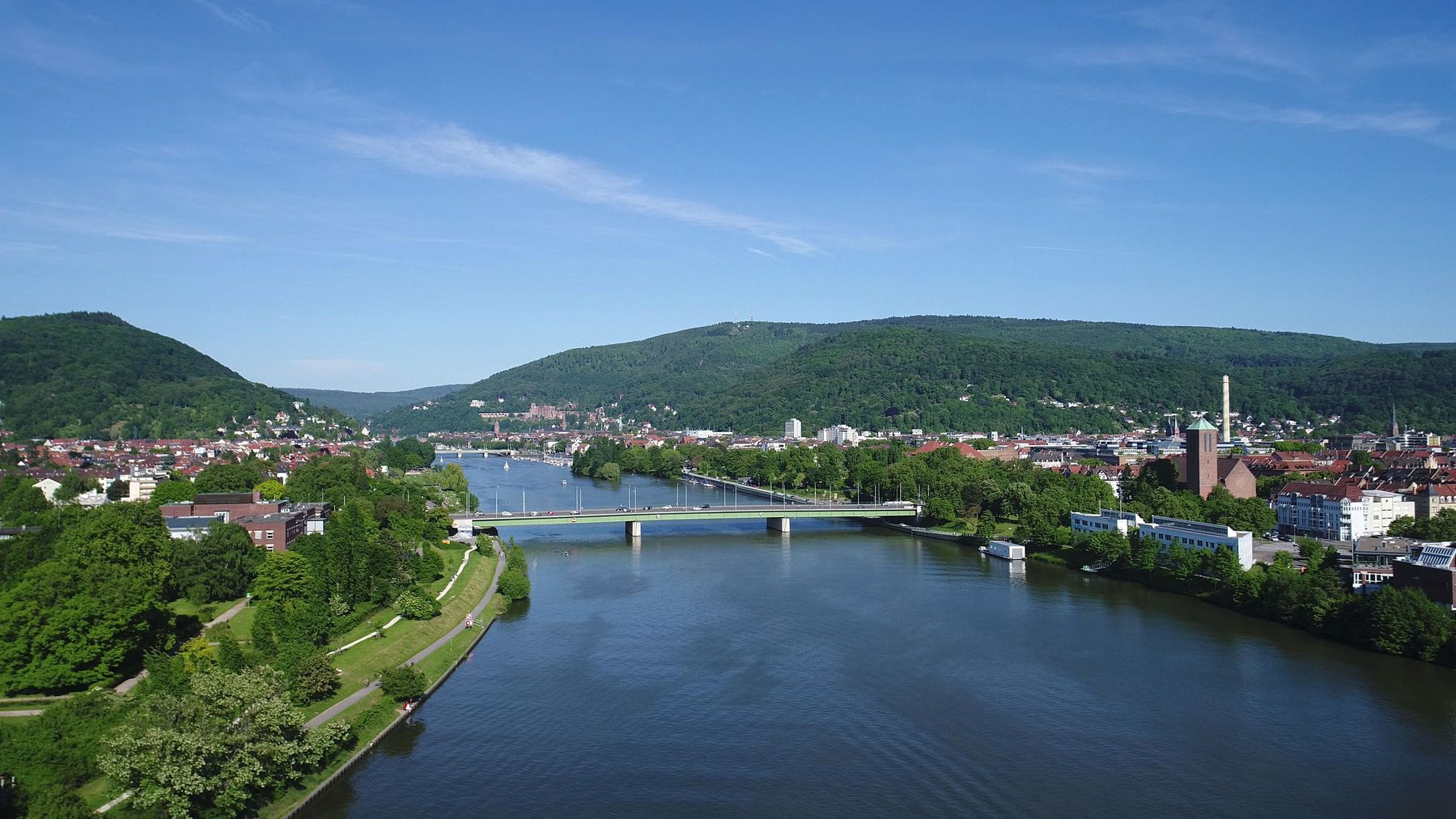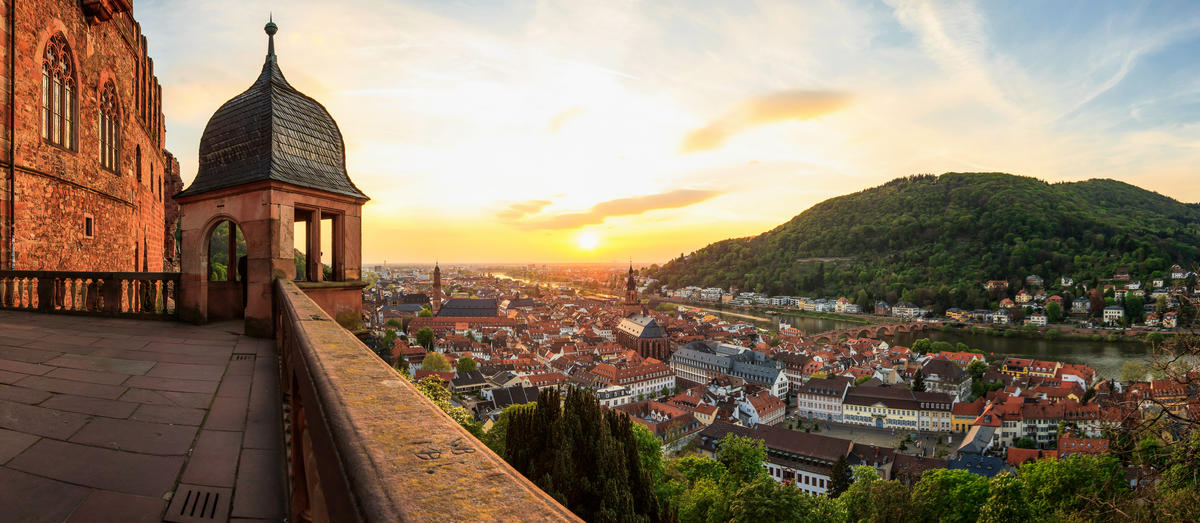Venue
Heidelberg
Heidelberg is a University town located in Baden-Württemberg in Germany with a population of around 160,000 people. Cut in two by the Neckar river, it sits on the edge of the Rhein valley and on one side has the hills and forest of the Odenwald, and on the other the flat plains of the valley. Whether in your time outside of the conference you are looking for a relaxed walk by the river, a hike up to the top of Königstuhl, sitting down with a beer and some traditional German food, or soaking in the historic sights of the castle, Heidelberg has it all to offer.
The local organising team are all members of the GIScience research group at the University of Heidelberg. In addition to state of the art research about topics like quality indicators for VGI data (such as OSM), the institute has also produced a number of useful services for the OSM community over the years, for example OpenRouteService or the data analysis platforms OSMatrix, osmlanduse.org, and ohsome. Another focus is on the usage of OSM in humanitarian and disaster contexts, where the local "disastermappers" organize frequent mapathons. The associated Heidelberg Institute for Geoinformation Technology (HeiGIT), supported by the Klaus Tschira Foundation, allows to translate theoretical work directly into practical solutions.
Conference – September 21 - 23
The 2019 State of the Map conference sessions will be held on the Neuenheimer Feld campus within the Chemistry lecture hall building. With a main auditorium that can hold 640 people and two smaller lecture halls which can each hold 200 people, there will be plenty of space for listening to some of the great talks that are sure to happen in the conference. In close proximity to this building there are a number of cafes, restaurants and supermarkets.
The venue location as well as all lecture rooms are accessible by wheelchair users. The Campus "Neuenheimer Feld" is located on the outskirts of Heidelberg centre, and is easily reachable from the whole city via public transport (two tram lines and two bus lines direcly connect it to the rest of the city). Or if you don't mind some physical activity, it is also reachable by foot (e.g. 20 minutes from the main train station) or bike (e.g. 15 minutes to the old town). In the campus area additional amenities can be found: a botanical garden (to ease your mind), shops (to ensure that you have what you need) and several cafes.
Sights and Attractions
Heidelberg has a lot to offer in terms of things to see and do. During the warmer months, many people like to sit by the river on the Neckarwiese and enjoy the sun with a BBQ and a few beers. For the more energetic people, taking a hike up to the top of the Königstuhl or a walk along the Philosophenweg offer both a bit of exercise and fantastic views of the city. Fancy a bit more culture? Not a problem! Heidelberg has many historic buildings including the Heidelberg Castle, a number of churches, and of course, the oldest university in Germany.
Heidelberg Castle was built in the 1400s and over the following centuries saw many additions and losses. Today the inside of the castle holds many artistic furnishings, and the outside has many things to see including extensive gardens and the Powder Turret which lies in ruins after an explosion many years ago.
Heidelberg University was founded in 1386 making it Germany's oldest university, and one of Europe's oldest institutions. Split over two main campuses, in the west of the city you can find the Neuenheimer Feld campus which houses most of the natural, computer and medical science faculties, along with a large number of leading edge hospital clinics. In the Altstadt you can find the old university campus which contains numerous historic buildings and houses mostly the social science and humanities faculties.
And let's not forget the Brückenaffe! Leading from the Altstadt to Neuenheim, the Old Bridge crosses the Neckar. On the Altstadt side of the bridge there is the Affenturm which is a gateway into the Altstadt. Next to this bridge is the Brückenaffe - a bronze statue of a monkey that forms the logo of the 2019 State of the Map conference. There are many stories about the monkey with older ones aiming at insulting other cities in Germany, but more recent ones focussing on protection and encouraging self-reflection.
Want to explore and see more from Heidelberg and the surrounding Neckar Valley? Take a boat ride to Neckarsteinach and back. The boats leave in front of the city hall. Find more information on when they leave and how to buy tickets here. And if you prefer to row yourself, just cross the river for the boat rental.
Around Heidelberg
Heidelberg is not only in the middle of the picturesque Neckar Valley, this valley is home to numerous castles and historic buildings. Only a couple of minutes up the river you can see four of them at once. Two of these can be visited doing short walks, another one, the Dilsberg fortress ruins is in the middle of a historic town and can be visited as well.
Another castle that is worth a visit, also due to its beautiful gardens is the Schwetzingen Palace, just 10 km out of Heidelberg.
The region around Heidelberg is furthermore famous for its wine. If you are interested in doing a tasting or visiting the vineyards, check out some sites in Schriesheim and Bad Dürkheim.
For people interested in technology, the nearby museums in Speyer, Sinsheim and Mannheim have a lot to offer. One can find exhibitions of aircraft and space flight, railway and automotive history and much more.Getting to Heidelberg
Heidelberg has a large central train station and an extensive public transport network which means getting to and around Heidelberg is relatively straight forward.
Planes
If you are flying to Germany for the conference there are a number of airports that are within easy reach of Heidelberg. For longer distance flights both Frankfurt and Stuttgart airports have connections to Heidelberg through a combination of long distance and local trains. Also, there are bus transfers available from both of these airports. Smaller airports including Karlsruhe/Baden-Baden and Frankfurt Hahn serve budget airlines, and normally have connections to Heidelberg through bus services. Stuttgart airport also caters for budget airlines.
Trains
Germany has an extensive railway network which offers long distance, regional, and even international train journeys. Though Heidelberg has a large train station, many international and faster long distance trains require a change in Mannheim, though the train connection between Mannheim and Heidelberg takes less than 15 minutes and there are many connections every hour.
Information about train times and connections can be found on the DeutscheBahn website.
For further information on local transport, please have a look at the Attending page regarding routes and tickets.
Automobiles
If you want to, you can also drive to Heidelberg in your own or a rented car. Please be aware however that most cities in Germany (including Heidelberg) have environment zones around the city centres where you need to have an environmental sticker on your car to enter. Also, parking in Heidelberg is quite limited, so it is best to check with your hotel beforehand.


